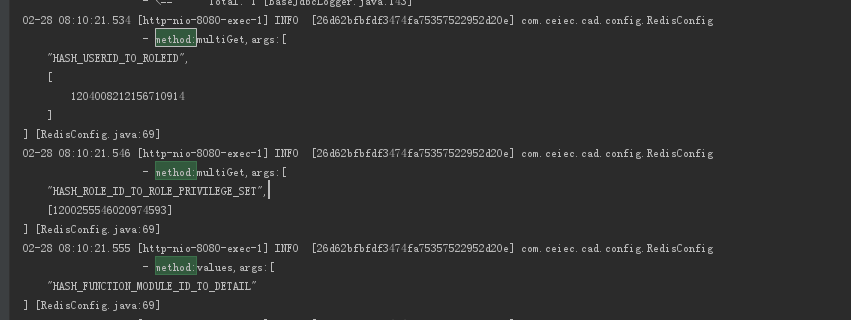曹工說Spring Boot原始碼(20)-- 碼網灰灰,疏而不漏,如何記錄Spring RedisTemplate每次操作日誌
寫在前面的話
相關背景及資源:
曹工說Spring Boot原始碼(1)-- Bean Definition到底是什麼,附spring思維導圖分享
曹工說Spring Boot原始碼(2)-- Bean Definition到底是什麼,咱們對著介面,逐個方法講解
曹工說Spring Boot原始碼(3)-- 手動註冊Bean Definition不比遊戲好玩嗎,我們來試一下
曹工說Spring Boot原始碼(4)-- 我是怎麼自定義ApplicationContext,從json檔案讀取bean definition的?
曹工說Spring Boot原始碼(5)-- 怎麼從properties檔案讀取bean
曹工說Spring Boot原始碼(6)-- Spring怎麼從xml檔案裡解析bean的
曹工說Spring Boot原始碼(7)-- Spring解析xml檔案,到底從中得到了什麼(上)
曹工說Spring Boot原始碼(8)-- Spring解析xml檔案,到底從中得到了什麼(util名稱空間)
曹工說Spring Boot原始碼(9)-- Spring解析xml檔案,到底從中得到了什麼(context名稱空間上)
曹工說Spring Boot原始碼(10)-- Spring解析xml檔案,到底從中得到了什麼(context:annotation-config 解析)
曹工說Spring Boot原始碼(11)-- context:component-scan,你真的會用嗎(這次來說說它的奇技淫巧)
曹工說Spring Boot原始碼(12)-- Spring解析xml檔案,到底從中得到了什麼(context:component-scan完整解析)
曹工說Spring Boot原始碼(13)-- AspectJ的執行時織入(Load-Time-Weaving),基本內容是講清楚了(附原始碼)
曹工說Spring Boot原始碼(14)-- AspectJ的Load-Time-Weaving的兩種實現方式細細講解,以及怎麼和Spring Instrumentation整合
曹工說Spring Boot原始碼(15)-- Spring從xml檔案裡到底得到了什麼(context:load-time-weaver 完整解析)
曹工說Spring Boot原始碼(16)-- Spring從xml檔案裡到底得到了什麼(aop:config完整解析【上】)
曹工說Spring Boot原始碼(17)-- Spring從xml檔案裡到底得到了什麼(aop:config完整解析【中】)
曹工說Spring Boot原始碼(18)-- Spring AOP原始碼分析三部曲,終於快講完了 (aop:config完整解析【下】)
曹工說Spring Boot原始碼(19)-- Spring 帶給我們的工具利器,建立代理不用愁(ProxyFactory)
工程程式碼地址 思維導圖地址
工程結構圖:

概要
本篇是獨立的,和前面幾篇aop相關分析沒有特別關聯,但是使用了上一篇提到的工具類。
曹工說Spring Boot原始碼(19)-- Spring 帶給我們的工具利器,建立代理不用愁(ProxyFactory)
之前也使用類似的思路,實現過完整sql日誌記錄。
曹工雜談--使用mybatis的同學,進來看看怎麼在日誌列印完整sql吧,在資料庫可執行那種
這兩天在搬磚,有個需求,是統計類的。一般來說,統計類的東西,比如要統計:使用者總數,使用者的新增總數,當天每個小時為維度的新增數量,各個渠道的新增使用者數量;這些,可能都得在redis裡維護,然後某個使用者註冊時,去把所有這些redis結構+1。
但這種程式碼,一般入口很多,修改這些值的地方很多,編碼時很容易發生遺漏,或者編碼錯誤,導致最後統計資料不準確。資料不準確,當然是bug,問題是,這種bug還不好排查。
如果能夠記錄下redis操作日誌就好了。
以下,是我已經實現的效果,這是一次請求中的一次redis操作,可以看到,是put方法。

實現思路
我們用的是spring boot 2.1.7,直接整合的RedisTemplate。當然,只要是使用RedisTemplate即可,和spring boot沒多大關係。
我看了下我們平時是怎麼去操作redis 的hash結構的,大概程式碼如下:
@Autowired
@Qualifier("redisTemplate")
private RedisTemplate<String,Object> redisTemplate;
HashOperations<String, HK, HV> ops = redisTemplate.opsForHash();
ops.put(key, hashKey,fieldValue);一般就是,先通過opsForHash,拿到HashOperations,再去操作hash結構。
我現在的想法就是,在執行類似ops的put的方法之前,把那幾個引數記錄到日誌裡。
要想讓ops記錄我們的日誌,我們只能攔截其每個方法,這一步就得使用一個代理物件,去替換掉真實的物件。
但是,怎麼才能讓redisTemplate.opsForHash()返回的ops,是我們代理過的物件呢?
所以,這一步,還得在生成redisTemplate的地方下功夫,讓其生成一個redisTemplate的代理物件,這個代理物件,攔截opsForHash方法。
總結下,需要做兩件事:
- 對redisTemplate做代理,攔截opsForHash方法;
- 在拿到第一步的原有的ops物件後,對ops物件做代理,攔截其put方法等。
程式碼實現
原有程式碼
@Configuration
public class RedisConfig {
@Bean
public RedisTemplate<String,Object> redisTemplate(RedisConnectionFactory redisConnectionFactory) {
RedisTemplate<String,Object> template = new RedisTemplate<>();
template.setValueSerializer(new CustomGenericJackson2JsonRedisSerializer());
template.setHashKeySerializer(new CustomHashKeyRedisSerializer());
template.setKeySerializer(RedisSerializer.string());
template.setHashValueSerializer(new CustomGenericJackson2JsonRedisSerializer());
template.setConnectionFactory(redisConnectionFactory);
return template;
}代理RedisTemplate
@Bean
public RedisTemplate<String,Object> redisTemplate(RedisConnectionFactory redisConnectionFactory) {
RedisTemplate<String,Object> template = new RedisTemplate<>();
template.setValueSerializer(new CustomGenericJackson2JsonRedisSerializer());
template.setHashKeySerializer(new CustomHashKeyRedisSerializer());
template.setKeySerializer(RedisSerializer.string());
template.setHashValueSerializer(new CustomGenericJackson2JsonRedisSerializer());
template.setConnectionFactory(redisConnectionFactory);
ProxyFactory proxyFactory = new ProxyFactory();
proxyFactory.setTarget(template);
proxyFactory.setProxyTargetClass(true);
proxyFactory.addAdvice(new MethodInterceptor() {
@Override
public Object invoke(MethodInvocation invocation) throws Throwable {
//攔截opsForHash
boolean b = invocation.getMethod().getName().equals("opsForHash");
if (b) {
// todo,下一步再完善這裡
}
return invocation.proceed();
}
});
//這裡獲取到針對template的代理物件,並返回
Object proxy = proxyFactory.getProxy();
return (RedisTemplate<String, Object>) proxy;
}大家可以仔細看上面的程式碼,利用了前一講我們學習了的ProxyFactory,來生成代理;使用它呢,比較方便,不用管底層它是用jdk動態代理,還是cglib代理,spring已經幫我們處理好了。
總之,上面這段,就是把redisTemplate給換了。我們具體要在攔截了opsForHash裡,做什麼動作呢?我們再看。
代理opsForHash的返回結果
@Bean
public RedisTemplate<String,Object> redisTemplate(RedisConnectionFactory redisConnectionFactory) {
RedisTemplate<String,Object> template = new RedisTemplate<>();
template.setValueSerializer(new CustomGenericJackson2JsonRedisSerializer());
template.setHashKeySerializer(new CustomHashKeyRedisSerializer());
template.setKeySerializer(RedisSerializer.string());
template.setHashValueSerializer(new CustomGenericJackson2JsonRedisSerializer());
template.setConnectionFactory(redisConnectionFactory);
ProxyFactory proxyFactory = new ProxyFactory();
proxyFactory.setTarget(template);
proxyFactory.setProxyTargetClass(true);
proxyFactory.addAdvice(new MethodInterceptor() {
@Override
public Object invoke(MethodInvocation invocation) throws Throwable {
boolean b = invocation.getMethod().getName().equals("opsForHash");
if (b) {
// 1. 這一步,拿到原有的opsForHash的返回結果
HashOperations hashOperations = (HashOperations) invocation.proceed();
//2. 下邊,對hashOperations進行代理
ProxyFactory proxyFactory = new ProxyFactory();
proxyFactory.setTarget(hashOperations);
proxyFactory.setProxyTargetClass(false);
proxyFactory.setInterfaces(HashOperations.class);
//3. 我們這個代理幹什麼事呢,就是加了一個方法前的攔截器,記錄日誌
proxyFactory.addAdvice(new MethodBeforeAdviceInterceptor(new MethodBeforeAdvice() {
// 使用fastjson格式化了引數,並記錄到日誌
@Override
public void before(Method method, Object[] args, Object target) {
log.info("method:{},args:{}",method.getName(),
JSON.toJSONString(args, SerializerFeature.PrettyFormat));
}
}));
// 這裡返回針對hashOperations的代理
return proxyFactory.getProxy();
}
return invocation.proceed();
}
});
Object proxy = proxyFactory.getProxy();
return (RedisTemplate<String, Object>) proxy;
}總結
我這個攔截比較粗,現在是把get類的日誌也打出來了。大家可以判斷下method的名稱,來自行過濾掉。

ok,本篇先到這裡。下講繼續講Spring ProxyFactory的內容
